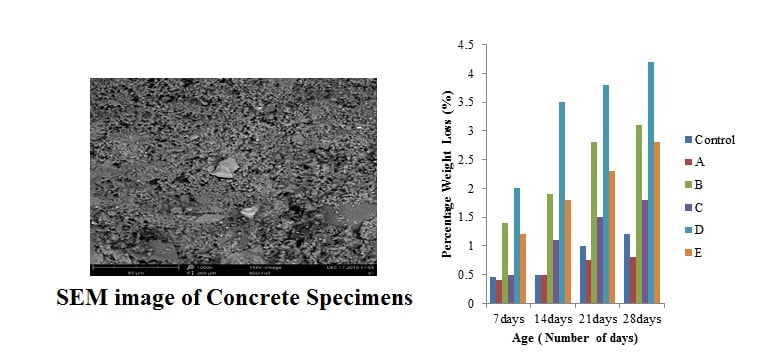Investigation of the microbial effect of wastewater on concrete performance
DOI:
https://doi.org/10.57056/ajet.v8i2.114Keywords:
Wastewater, Concrete, Microorganism, BacteriaAbstract
Concrete subjected to wastewater environment deteriorates faster than its counterpart in an ordinary environment. The investigation also showed that the deterioration effect could also be counteracted using bacteria. This study investigated the deterioration and healing effects of bacteria isolated from wastewater on concrete properties like weight loss, compressive strength, modulus of elasticity and SEM analysis. The result at 28 days of curing showed that the greatest reduction in weight (4.2%) and compressive strength (16.69%) compared with control was observed in concrete inoculated with S. epidermidis; while the least decrease in weight (0.8%) and an increase in compressive strength (1.79%) was observed with the concrete cast with potable water and cured in nutrient broth medium. The healing effect of B. subtilis on the concrete was also considered and analyzed, the result showed that B. subtilis improved the strength of the concrete exposed to S. epidermidis. Scanning Electron Microscopy analysis showed that an increase in the pores within the concrete leads to a reduction in compressive strength.
References
Olonade K.A. A review of the effects of wastewater on reinforced concrete structures in Nigeria. Nigeria Journal of Technology. 2016; 35(2):234-241.
Natarajan KA. Microbially induced concrete corrosion. Advanced in Corrosion Engineering, 2012; 1(1)1-9.
Shipping W, Zhenglong J, Hao L, Dongsheng Z, Mauricio S. Microbiologically Induced Deterioration of Concrete. Brazillian Journal of Microbiology., 2013; 44(4):1001-1007.
Cho K, Mori T. A newly isolated fungus participates in the corrosion of concrete sewer pipes. Water Science and Technology, 1995; 31(1):263-271.
Monteny N, Debelie E, Vinke V, Taerwe L. Chemical and microbiological test to simulate sulphuric acid corrosion of polymer-modified concrete. Cement and Concrete Research, 2001; 31(9):1359-1365.
Sanchez-Silva M, Rosowsky D. Biodeterioration of construction materials: state of art and future challenges. Journal of Materials in Civil Engineering, 2008; 20(1):352-365.
Bertron A, Escadeillas G, Duchesne J. Cement paste alteration by liquid manure organic acids: chemical and mineralogical characterization. Cement and Concrete Research, 2004; 34(1):1823-1835.
Diercks M, Sand W, Bock E. Microbial corrosion of concrete from the corroded sewer pipe. Experientia, 1991; 47(1):514-16.
Hewayde E, Nehdi M, Allouche E, Nakhia G. Using concrete admixtures for sulphuric acid resistance. In Proceedings of the Institution of Civil Engineers Construction Materials.; 2007.
Adesanya D, Raheem, A. A study of the permeability and acid attack of corn cob ash blended cement. Construction and Building Materials, 2010; 24(3):403-09.
Blaiszik BJ, Kramer LB, Olugebefola SC, Moore JS, Sottos NR, White SR. Self-healing polymers and composite. Annual Review of Materials Research, 2010; 40(1):179-211.
Sunil PR, Seshagiri RM, Aparna P, Sasikala C. Performance of standard grade bacterial (bacillus subtilis) concrete. Asian Journal of Civil Engineering, 2010; 11(1):43-55.
ACI Committee 318 Report. Building Code Requirements for Structural Concrete and Commentary. ACI 318-08, American Concrete Institute, Farmington Hills, Michigan. 2008; 107
Magniont C, Coutand M, Bertron A, Cameleyre X, Lafforgue C, Beaufort S, Escadeillas G. A new test method to assess the bacterial deterioration of cementitious materials. Cement and Concrete Research., 2011; 41(1):429-438.
Mustafa OM. Reinforcement of beams by using carbon fibre reinforced polymer in concrete buildings. Science Resolution Essays, 2009; 2(2)1136-1145
Bridges JC, Catling DC, Saxton JM, Swindle TD, Lyon IC, Grady MM. Alteration assemblages in Martian meteorites: implications for near-surface processes. Space Science Reviews, 2001; 96(1-4):365-392.
Riba-Silva M. The microscopic study of biodegradation of concrete submitted to cold humid climate. Proc., 5th Euroseminar on Microscopy Applied to Building Materials, Belgian Building Research Institute, Loeven, Belgium, 2015; 162-169
Jorge FM, Mauricio S, Johana H, Emilio B. Effects of biodeterioration on the mechanical properties of concrete. Journal of Materials and Structures, 2016; 1(1):774-778
Varenyam A, Abhijit M, Sudhakara, M. Microbial concrete: a way to enhance the durability of concrete structures. Journal of Materials in Civil Engineering., 2010; 10(1):1943-1950.
Rajeswari N, Nagamani B, Facundo C, Jose B. An eco-sustainable approach to increase the compressive strength of cement mortar using ureolytic bacteria. International Journal of Engineering and Technical Research, 2016; 5(2):173-76.
Mtallib MO. Compressive strength of concrete in contact with nitrate-based substances. In Proceeding the Millennium Conference building in the 21st century. Zaria, 2002. Department of Building, Ahmadu Bello University, Zaria. Nigeria.

Downloads
Published
How to Cite
Issue
Section
License
Copyright (c) 2023 Solomon Temidayo Olowolafe, Catherine M Ikumapayi

This work is licensed under a Creative Commons Attribution-NonCommercial 4.0 International License.





